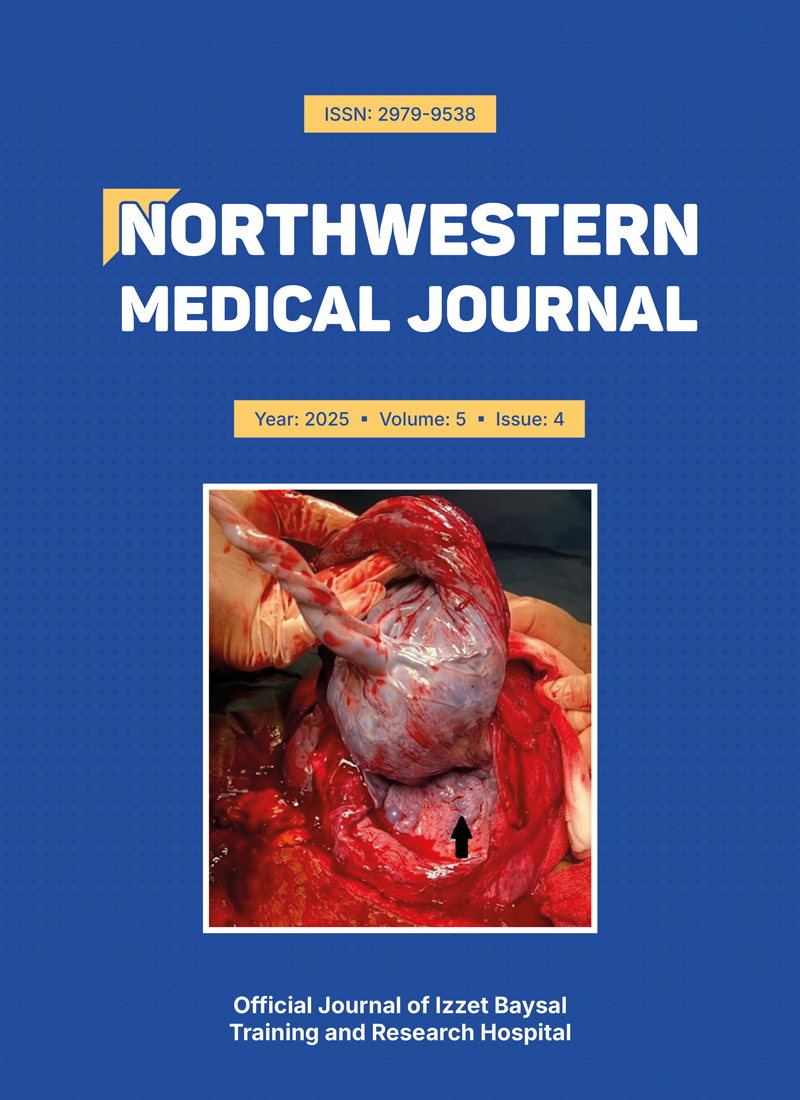Abstract
Obstetric risks are increased in pregnancies following previous cesarean section deliveries. Placenta increta and placenta previa pregnancies are two important clinical manifestations of abnormal placentation entities. Placenta accreta occurs in 5-10% of pregnancies complicated by placenta previa. The most important risk factor for placenta accreta is a history of uterine surgery. A thin, defectively formed or absent decidua basalis layer cannot show resistance to deep penetration of trophoblasts and placenta invades this pathological region of uterus that has previously been traumatised by uterine surgery. Placenta accreta is diagnosed with characteristic signs during prenatal ultrasound examination. The first clinical sign of placenta accreta is excessive and life-threatening bleeding that occurs during manual placental separation. Prenatal diagnosis is important to avoid this complication, which may lead to maternal mortality. In this case, in which an invasion anomaly was detected in preoperative ultrasonography, the treatment of the patient accompanied by placenta increta and placenta praevia with uterus-preserving surgery was discussed.
Keywords: placenta increta, placenta previa, uterine sparing surgery, clinical approach
Copyright and license
Copyright © 2025 The Author(s). This is an open-access article published by Bolu İzzet Baysal Training and Research Hospital under the terms of the Creative Commons Attribution License (CC BY) which permits unrestricted use, distribution, and reproduction in any medium or format, provided the original work is properly cited.
How to cite
References
- Cunningham FG, Leveno KJ, Bloom SL, Dashe JS, Hoffman BL,Casey BM, Spong CY. Wiiliams Obstetrics. 2020: 775.
- Rao KP, Belogolovkin V, Yankowitz J, Spinnato JA. Abnormal placentation: evidence-based diagnosis and management of placenta previa, placenta accreta, and vasa previa. Obstet Gynecol Surv. 2012; 67(8): 503-19. https://doi.org/10.1097/OGX.0b013e3182685870
- Silver RM, Branch DW. Placenta Accreta Spectrum. N Engl J Med. 2018; 378(16): 1529-36. https://doi.org/10.1056/NEJMcp1709324
- Kale İ, Uluutku GB, Ergin B. Placenta previa and invasion anomalies; a retrospective analysis of cases in a tertiarty obstetric care center. The Journal of Gynecology - Obstetrics and Neonatology. 2021; 18(1): 662-70. https://doi.org/10.38136/jgon.772048
- Rosenberg T, Pariente G, Sergienko R, Wiznitzer A, Sheiner E. Critical analysis of risk factors and outcome of placenta previa. Arch Gynecol Obstet. 2011; 284(1): 47-51. https://doi.org/10.1007/s00404-010-1598-7
- Wu S, Kocherginsky M, Hibbard JU. Abnormal placentation: twenty-year analysis. Am J Obstet Gynecol. 2005; 192(5): 1458-61. https://doi.org/10.1016/j.ajog.2004.12.074
- Zelop C, Nadel A, Frigoletto FD, Pauker S, MacMillan M, Benacerraf BR. Placenta accreta/percreta/increta: a cause of elevated maternal serum alpha-fetoprotein. Obstet Gynecol. 1992; 80(4): 693-4.
- Hung TH, Shau WY, Hsieh CC, Chiu TH, Hsu JJ, Hsieh TT. Risk factors for placenta accreta. Obstet Gynecol. 1999; 93(4): 545-50. https://doi.org/10.1016/s0029-7844(98)00460-8
- Zelop CM, Harlow BL, Frigoletto FD, Safon LE, Saltzman DH. Emergency peripartum hysterectomy. Am J Obstet Gynecol. 1993; 168(5): 1443-8. https://doi.org/10.1016/s0002-9378(11)90779-0
- Kayem G, Davy C, Goffinet F, Thomas C, Clément D, Cabrol D. Conservative versus extirpative management in cases of placenta accreta. Obstet Gynecol. 2004; 104(3): 531-6. https://doi.org/10.1097/01.AOG.0000136086.78099.0f
- Oyelese Y, Smulian JC. Placenta previa, placenta accreta, and vasa previa. Obstet Gynecol. 2006; 107(4): 927-41. https://doi.org/10.1097/01.AOG.0000207559.15715.98
- Arulkumaran S, Ng CS, Ingemarsson I, Ratnam SS. Medical treatment of placenta accreta with methotrexate. Acta Obstet Gynecol Scand. 1986; 65(3): 285-6. https://doi.org/10.3109/00016348609155187
- Adair SR, Elamin D, Tharmaratnam S. Placenta increta; conservative management -- a successful outcome. Case report and literature review. J Matern Fetal Neonatal Med. 2004; 15(4): 275-8. https://doi.org/10.1080/14767050410001668699
- Palacios Jaraquemada JM, Pesaresi M, Nassif JC, Hermosid S. Anterior placenta percreta: surgical approach, hemostasis and uterine repair. Acta Obstet Gynecol Scand. 2004; 83(8): 738-44. https://doi.org/10.1111/j.0001-6349.2004.00517.x
- American College of Obstetricians and Gynecologists. ACOG Practice Bulletin: Clinical Management Guidelines for Obstetrician-Gynecologists Number 76, October 2006: postpartum hemorrhage. Obstet Gynecol. 2006; 108(4): 1039-47. https://doi.org/10.1097/00006250-200610000-00046
- Garmi G, Goldman S, Shalev E, Salim R. The effects of decidual injury on the invasion potential of trophoblastic cells. Obstet Gynecol. 2011; 117(1): 55-9. https://doi.org/10.1097/AOG.0b013e31820094f3
- Sentilhes L, Ambroselli C, Kayem G, et al. Maternal outcome after conservative treatment of placenta accreta. Obstet Gynecol. 2010; 115(3): 526-34. https://doi.org/10.1097/AOG.0b013e3181d066d4
- Karateke A, Küçükbaş M, Sozen H, Namazov A, Cakır S, Akdemir Y. Fertility sparing surgery on placenta invasion anomalies and placenta previa. Iran J Reprod Med. 2012; 10(3): 271-4.
- Goudarzi F, Khadivzadeh T, Ebadi A, Babazadeh R. Women’s interdependence after hysterectomy: a qualitative study based on Roy adaptation model. BMC Womens Health. 2022; 22(1): 40. https://doi.org/10.1186/s12905-022-01615-2
- Grover B, Einerson BD, Keenan KD, et al. Patient-reported health outcomes and quality of life after peripartum hysterectomy for placenta accreta spectrum. Am J Perinatol. 2022; 39(3): 281-7. https://doi.org/10.1055/s-0040-1715465
- Kaba M. Invasion anomaly or neovascularization? A new surgical approach for cesarean delivery in pregnant women with invasive placenta accreta spectrum disorder accompanied by placenta previa. Ginekol Pol. 2024; 95(2): 114-22. https://doi.org/10.5603/GP.a2023.0072
- Timmermans S, van Hof AC, Duvekot JJ. Conservative management of abnormally invasive placentation. Obstet Gynecol Surv. 2007; 62(8): 529-39. https://doi.org/10.1097/01.ogx.0000271133.27011.05
- Eller AG, Bennett MA, Sharshiner M, et al. Maternal morbidity in cases of placenta accreta managed by a multidisciplinary care team compared with standard obstetric care. Obstet Gynecol. 2011; 117(2 Pt 1): 331-7. https://doi.org/10.1097/AOG.0b013e3182051db2
- Jauniaux E, Ayres-de-Campos D, Langhoff-Roos J, Fox KA, Collins S, FIGO Placenta Accreta Diagnosis and Management Expert Consensus Panel. FIGO classification for the clinical diagnosis of placenta accreta spectrum disorders. Int J Gynaecol Obstet. 2019; 146(1): 20-4. https://doi.org/10.1002/ijgo.12761











